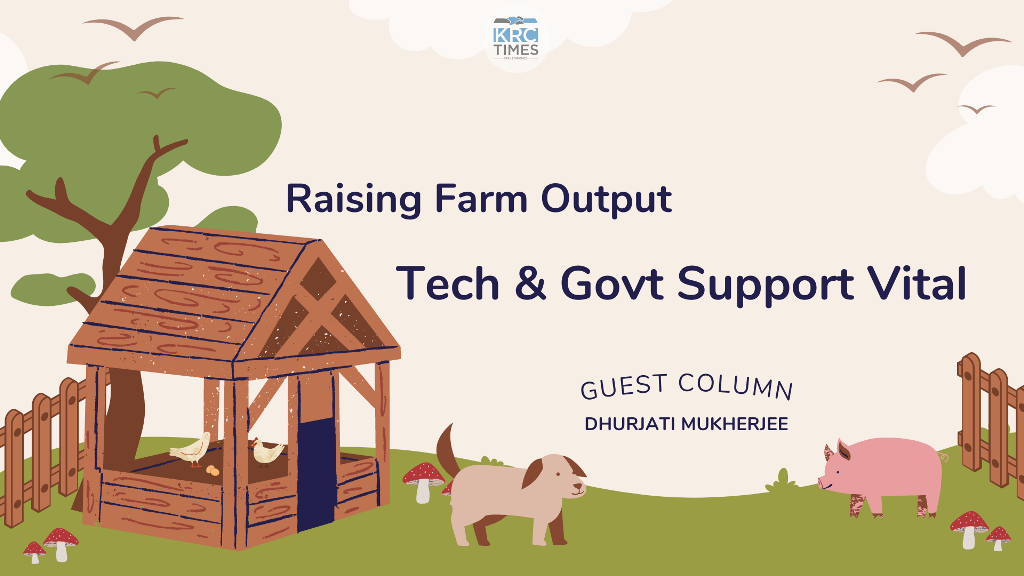Food grain production has to be increased to keep pace with demand, the International Food Policy Research Institute estimated that India would be facing a 16 percent drop in food production with the number of those at risk for hunger increasing by 23 percent by 2030 due to climate change
 Dhurjati Mukherjee I INFA Service
Dhurjati Mukherjee I INFA Service

Prime Minister Narendra Modi has urged States to step up domestic production by accelerating the process for the modernisation of agriculture, animal husbandry and food processing to help India become self-sufficient and a global leader in the farm sector. At the 7th meeting of the Niti Aayog Governing Council, he sought to impress upon States to focus on reducing imports, increasing exports and identifying opportunities for shipping goods out of India, more so due to supply constraints and the war in Ukraine.
With the import of edible oil being around Rs 1lakh crore annually, Niti Aayog Member, Ramesh Chand lamented that nearly half of the country’s requirement for the cooking medium was met from foreign supplies. As usual, the need for crop diversification was rightly stressed keeping in view the precarious problem of groundwater in States such as Punjab and Haryana. The agriculture economist wanted a more attractive MSP for pulses and oilseeds to wean away farmers from paddy and wheat, the mainstay of India’s procurement programme.

However, paddy and wheat output cannot be ignored as their requirement has been increasing. Recent reports indicate that production of kharif foodgrains is expected to decline by nearly 4 percent with the biggest slide of 6 percent being recorded in the output of paddy during 2022-23 crop year over 2021-22 due to drought conditions in certain States, including Uttar Pradesh, Bihar and Punjab, that witnessed significant monsoon rainfall deficit this year. The first advance estimates of kharif crops, released by the Agriculture Ministry, showed the estimated overall production of foodgrain at nearly 150 million tonnes in 2022-23 compared to 156 MT in the previous fiscal.
As far as paddy is concerned, the decline is expected to be around 7 million tonnes in the current crop year (July-June cycle). Improvement in the production of coarse cereals (millets and maize) has, however, slightly bridged the estimated output, thanks to maize whose production due to crop diversification efforts during the current fiscal is estimated at record MT.
Meanwhile, recent reports indicated that there is a fall in the summer crop acreage due to drought conditions in six States, including UP, Bihar and Jharkhand. The overall acreage of kharif crops was dragged down largely due to fall in nearly 5 percent in sown area of paddy as also in sowing of pulses and oilseeds due to inadequate rainfall. Additionally, the average retail prices of rice, wheat and atta increased by 8 to 19 percent this past year, according to government data with the maximum increase being in the case of atta (wheat flour) prices.

Scientists generally agree that Indian agriculture faces diverse problems. These include a lack of proper infrastructure and know-how, faith in conventional styles of functioning, lack of awareness and scarcity of farmer capital while fragmentation of land holdings has been another big hurdle. The country, which accounts for 18 percent of the global population, is expected to surpass China by 2023, thereby necessitating more food production. Estimations by the Indian Council for Agricultural Research (ICAR) showed that by 2050, demand for pulses, cereals, rice, eggs, fruits, vegetables and milk will be more than twice what it was in 2000, while the demand for foodgrains is expected to jump by over 85 percent.
While food grain production has to be increased to keep pace with demand, the International Food Policy Research Institute estimated that India would be facing a 16 percent drop in food production with the number of those at risk for hunger increasing by 23 percent by 2030 due to climate change. This revelation is significant since it comes in the wake of India’s poor showing in the Global Hunger Index 2022, wherein it ranked 101 out of 116 nations. A need-based minimum core essentially means that States need to ensure that a minimum acceptable level of food is provided for citizens’ needs and survival.

However, India has been trying to comply with the commitment to guaranteeing adequate daily calorie requirements for its populace through a judicious mix of legal and policy initiatives like the Green Revolution, the Public Distribution System and the National Food Security Act, of 2013. But in reality, a section of the rural population is undernourished as it does not have the purchasing power to have a balanced diet with the necessary proteins and minerals.
Thus, lies the need of enhancing farm productivity. Providing more food, and increasing productivity affect the farming market’s growth, labour migration, and income. Increased agricultural productivity refers to the more efficient distribution of scarce resources. Learning how to improve production is a crucial aspect of productive farming. New methods and techniques have given farmers a chance to increase production and maintain their farm’s long-term sustainability.
Agricultural experts believe that climate change has been impacting the sector and nutritional stability. Increasing temperatures, erratic rainfall and droughts at odd times are having an adverse effect on plant growth, causing shorter grain filing periods, and reduced yield and biomass. Keeping in view the need to safeguard the nutritional requirement of the population, millets, which include sorghum (jowar), pearl millet (bajra), finger millet (ragi), barnyard and other such varieties, offer a viable option as these nutraceutical crops are rich sources of macro-nutrients and micronutrients with high levels of calcium, iron, zinc, potassium and protein. Thus, diversification of crops is very much necessary.
Meanwhile, it has been reported that shortages of water, land and energy combined with the increased demand from population and economic growth will create a global food shortage around 2050 and India is no exception.
Recall, a Supreme Court order aptly stated that no person should die of hunger “but that is happening, citizens are dying of hunger”, asking the Centre and States to reach out to farmers and migrants who form the country’s backbone. It noted the Centre had failed to undertake any exercise to determine the coverage under the Food Security Act as a result of which a staggering 10 crore people had been left out of its purview and lakhs of migrants failed to secure foodgrains during the pandemic despite the court issuing a slew of directives. Perhaps, keeping this in view, the Centre extended the free ration scheme for the poor by another three months i.e. up to December-end.
It’s imperative to take adequate measures to boost agricultural growth. Obviously, productivity has to increase in States that are below the national average. Plus, one cash crop must be grown to increase farmers’ income. For this, technological support is critical and research institutes like ICAR need to come forward in locating at least 200-250 districts where cash crop production must be encouraged.
Further, experts raise the question of how Public-private partnerships can unlock opportunities for private investment to complement public resources and capacity to generate improved food security, particularly for the most vulnerable population. There is a need for the allocation of more resources from the Centre, promoting good nutrition, better local farming methods, increasing local food processing and, of course, better technological inputs which India’s scientific institutions can provide.
Only then can India emerge as a major food hub in the world. Proper technological inputs and government support need serious consideration. More so, because there is enough demand in certain categories of crops and the country can earn reasonable profits by maintaining sustainable exports. Why wait? —INFA
Promotional | KRC Foundation

Know more




